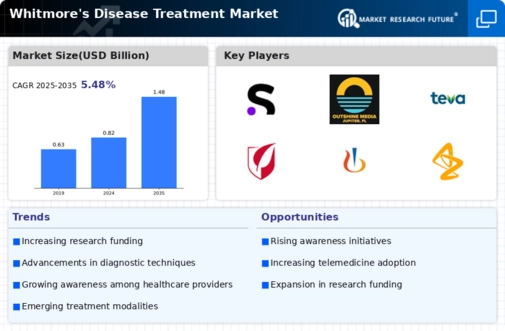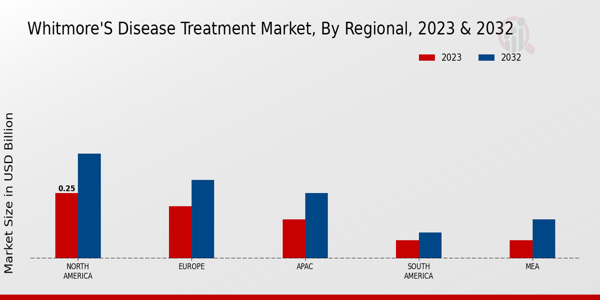Market Growth Projections
The Global Whitmore's Disease Treatment Market Industry is projected to experience substantial growth over the next decade. With an estimated market value of 0.82 USD Billion in 2024, it is anticipated to reach 1.48 USD Billion by 2035, reflecting a CAGR of 5.49% from 2025 to 2035. This growth trajectory is influenced by various factors, including increasing disease incidence, advancements in diagnostics, and the introduction of new treatment options. The market's expansion is indicative of the ongoing efforts to address Whitmore's disease and improve patient care on a global scale.
Emerging Treatment Options
The emergence of novel treatment options is reshaping the Global Whitmore's Disease Treatment Market Industry. Recent research has led to the development of new antibiotics and therapeutic strategies that show promise in combating the disease. These advancements not only provide alternatives for patients but also address the challenge of antibiotic resistance, which is a growing concern in infectious disease management. As these innovative treatments become available, they are likely to enhance patient outcomes and drive market growth. The introduction of such therapies could be a game-changer, potentially increasing the market's overall value as demand for effective solutions rises.
Rising Awareness and Education
Increasing awareness and education about Whitmore's disease among healthcare professionals and the public are driving the Global Whitmore's Disease Treatment Market Industry. Educational campaigns led by health organizations are crucial in informing communities about the symptoms, transmission, and prevention of the disease. As awareness grows, individuals are more likely to seek medical attention promptly, leading to higher treatment demand. This heightened awareness is anticipated to support market growth, as healthcare systems adapt to meet the needs of affected populations. The cumulative effect of these educational efforts may significantly influence treatment accessibility and market dynamics.
Government Initiatives and Funding
Government initiatives aimed at combating infectious diseases are playing a pivotal role in the Global Whitmore's Disease Treatment Market Industry. Various health authorities are allocating funds for research and development, public awareness campaigns, and improved healthcare infrastructure. For example, national health programs in endemic regions are focusing on enhancing treatment accessibility and affordability. Such initiatives not only aim to reduce the burden of Whitmore's disease but also stimulate market growth by fostering innovation in treatment methodologies. This proactive approach is expected to bolster the market's value, contributing to its projected growth trajectory.
Advancements in Diagnostic Techniques
Recent advancements in diagnostic techniques are significantly impacting the Global Whitmore's Disease Treatment Market Industry. Enhanced methods, such as molecular diagnostics and rapid antigen tests, facilitate earlier and more accurate detection of the disease. This early diagnosis is crucial for timely intervention, which can improve patient outcomes and reduce mortality rates. As healthcare providers adopt these innovative diagnostic tools, the demand for effective treatment options is likely to rise. The market is expected to grow at a CAGR of 5.49% from 2025 to 2035, ultimately reaching a value of 1.48 USD Billion by 2035.
Increasing Incidence of Whitmore's Disease
The rising incidence of Whitmore's disease, particularly in tropical and subtropical regions, is a primary driver of the Global Whitmore's Disease Treatment Market Industry. As environmental conditions become more favorable for the bacteria causing this disease, the number of reported cases is expected to increase. For instance, countries like Thailand and Malaysia have documented a surge in cases, prompting healthcare systems to enhance their treatment protocols. This growing prevalence is projected to contribute to the market's expansion, with an estimated value of 0.82 USD Billion in 2024, reflecting the urgent need for effective treatment options.












